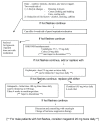Management of hot flashes in women with breast cancer
- PMID: 20179808
- PMCID: PMC2826783
- DOI: 10.3747/co.v17i1.473
Management of hot flashes in women with breast cancer
Abstract
Hormone-suppression therapies are used for the treatment of breast cancer in the adjuvant and metastatic settings alike. However, side effects-including hot flashes-are frequently reported by patients as a cause of therapy discontinuation. This paper presents an overview of hormonal therapies and the evidence-based management options for hot flashes, summarized in a treatment algorithm.
Keywords: Breast cancer; aromatase inhibitors; hot flashes; tamoxifen.
Figures
References
-
- Bonneterre J, Buzdar A, Nabholtz JM, et al. Anastrozole is superior to tamoxifen as first-line therapy in hormone receptor positive advanced breast carcinoma. Cancer. 2001;92:2247–58. - PubMed
-
- Coates AS, Keshaviah A, Thürlimann B, et al. Five years of letrozole compared with tamoxifen as initial adjuvant therapy for postmenopausal women with endocrine-responsive early breast cancer: update of study big 1-98. J Clin Oncol. 2007;25:486–92. - PubMed
-
- Coombes RC, Hall E, Gibson LJ, et al. on behalf of the Inter-group Exemestane Study. A randomized trial of exemestane after two to three years of tamoxifen therapy in postmenopausal women with primary breast cancer. N Engl J Med. 2004;350:1081–92. - PubMed
-
- Partridge AH, Wang PS, Winer EP, Avorn J. Nonadherence to adjuvant tamoxifen therapy in women with primary breast cancer. J Clin Oncol. 2003;21:602–6. - PubMed
-
- Oldenhave A, Jaszmann LJ, Haspels AA, Everaerd WT. Impact of climacteric on well-being. A survey based on 5213 women 39 to 60 years old. Am J Obstet Gynecol. 1993;168:772–80. - PubMed
LinkOut - more resources
Full Text Sources
Other Literature Sources


